#El Qantara
Video
Arab-Israeli War 1967 by manhhai
Via Flickr:
Israeli soldier stands atop the wreckage of Sukhoi-7 Egyptian fighter jet that was brought down by Israeli anti-aircraft guns and crashed nine miles northeast of El Qantara, Dec. 7, 1967. (AP Photo/Michel Lipchitz)
2 notes
·
View notes
Text
Banu Qasi triology: Locations (+ Maps extracted from the book and modern reconstruction of plans of some cities of that period of time I found on Internet)
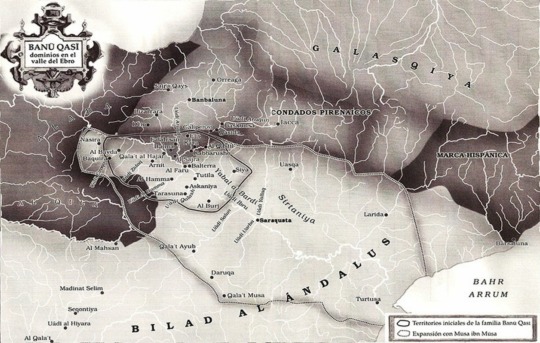


(* Some towns and cities that already existed are not in this maps, but probably were not included in the maps because maybe they're not relevant for the story, X, X, X )
Zaragoza (×) (although this one represents the Zaragoza from 11th century, due to the presence of the Palace of Aljaferia (×), although a watchtower existed since 9-10th centuries in that place, the Troubadour's Tower, that currently forms part of the palace)
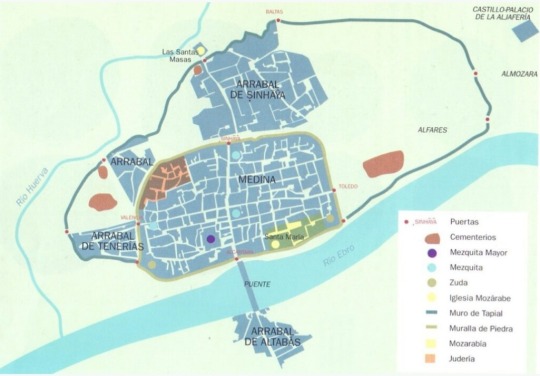
Tudela, but here's a video of Pamplona/Iruña
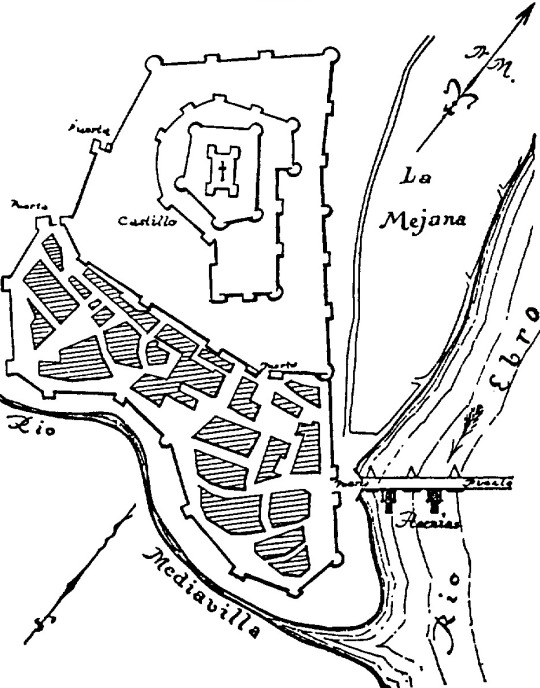
Córdoba (Here's a video with the current-day Alcázar and the Caliphal baths)
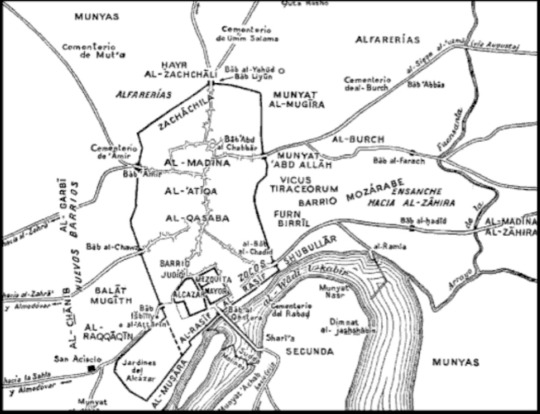
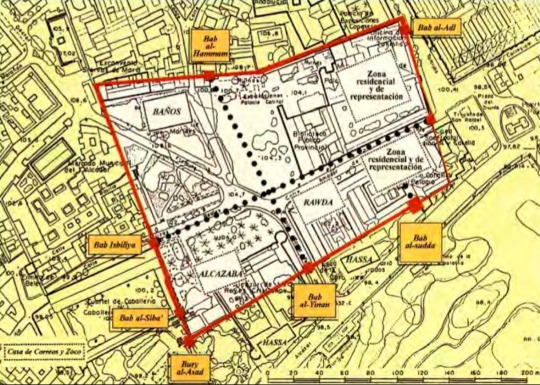

Toledo
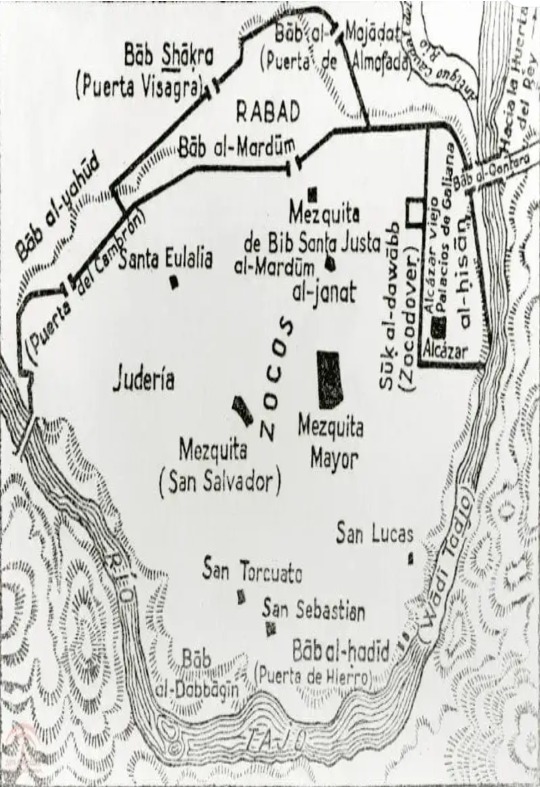
Alaba: Álava
Al Bayda, Albayda: Albelda
Al Burj: Borja
Al Busherat: Las Alpujarras
Al Faru: Alfaro
Al Garb: 'the west', Algarve
Al Hamma: Alhama
Al Hamma: site that corresponds to the current Baños de Fitero
Al Hamra: 'the red', the Alhambra of Granada
Al Lura: Álora
Al Maghrib: current Maghreb area, Morocco, Algeria and Mauritania
Al Mahdiyya: capital of the Fatimid Caliphate founded by Al Mahdi
Al Mariya: Almería
Al Mahsan: Almazán
Al Mudawar: Almudévar
Al Munastir: Almonacid
Al Qala't: Alcalá de Henares
Al Qāhira: Cairo
Al Qastil: Carcastillo or Murillo el Fruto
Al Qila: Castile
Al Qulaiya: Alcolea
Al Qubba: Talavera
Al Rawda: one of the interior gardens of the alcazar of Córdoba, where most of the emirs were buried
Al Sarqiyya: Axarquía, in Granada
Al Xaraf: Aljarafe
Al Jazira: Algeciras
Almunya de Aisha: Muniesa
Al Sajra: Azagra
Antaqira: Antequera
Arnit: Arnedo
Aryiduna: Archidona
Askaniya: Cascante
Asturqa: Astorga
Asnad:Cenes
Astīban: fortress located in the current-day Alhambra
Aura: Fortress next to Barcelona, possibly in present-day Valldaura
Aybar: Aibar
Bab al Qantara: the Bridge Gate, in Córdoba, also known as Bab as-Sudda or the Azud Gate
Baghdad: capital of the Abbasid emirate
Bagúh: Priego
Bahr Algarbí: Atlantic Ocean
Bahr Arrum: Mediterranean sea
Balaga: Balager
Balma: place located on the left bank of the Ebro river next to Calahorra, it may correspond to the town of San Adrián
Balansiya: Valencia
Balterra: Valtierra
Bambaluna: Pampiluna, Pamplona
Banu Basir: Benameji
Baquira: Viguera
Barbitaniya: región of Sobrarbe, that included Jaca, Barbastro and Boltaña
Barsaluna: Barcelona
Baskunsa: place name that would correspond to the fortress of Rocaforte, which after the Reconquest, it would give to the current Sangüesa, located at the foot of this valley
Batalyus: Badajoz
Barbastur: Barbastro
Bayanna: Baena
Bayāna: Pechina, important trading city of the Mediterranean sea, replaced by the port of Almería
Basta: Baza
Bilad al Ándalus: Hispania
Bulāy: Poley, Aguilar de la Frontera
Burbaster: Bobastro, Umar ibn Hafsún's shelter
Cantabria: mountain range that borders river Ebro by the north, next to Logroño
Castro Muros: San Esteban de Gormaz
Dar al Islam: the lands of Islam
Dar al Rahn: the House of Hostages, in Córdoba
Daniya: Denia
Daruqa: Daroca
Deio: Monjardín
Dus Amantis: the Rock of the Lovers
Falah'san: Falces
Fās: Fez, capital of the Idrisi emirate
Finyāna: Fiñans
Galaskiya: Land of the galaskiyun, the gascons
Galipenzo: Gallipienzo
Garnata: Granada
Girunda: Girona
Hardaris: Ardales
Hisn Asar: Iznájar
Hisn Qámara: castle of uncertain location, near Colmenar and Casabermeja, in the province of Málaga
Hisn Qastuluna: the ancient Roman city Cástulo, in Jaén
Iacca: Jaca
Ifriqiya: Tunisia
Ilbira: Elvira, next to Granada, capital of the distrit with the same name.
Isbāniyā: Christian chroniclers called the peninsula as a whole Hispania. For the Arabs, Al Ándalus is only the land dominated by Islam. They call the Christian land by the name of their kingdoms, and the term Isbāniyā is reserved for the entire peninsula, although it is rarely used.
Ishbiliya: Sevilla
Istiba: Estepa
Istiya: Écija
Kabbaruso: Caparroso
Kara: Santacara
Larida: Lleida
Ledena: Liédena
Leqant: Fuente de Cantos
Liyun: León
Lizarrara: Estella-Lizarra
Madinat Selim: Medinaceli
Madinat al Faray: Guadalajara
Malaqa: Málaga
Mārida: Mérida
Martus: Martos
Milīla: Melilla
Millas: Mijas
Muish: Muez
Munt Sun: Monzón
Munt Liyūn: Monteleón
Mursiya: Murcia, also known as Tudmir (this name comes from the Visigothic count Teodomiro, who ruled it by the time the Muslims arrived to the Peninsula)
Nasira: Nájera
Niebla: District that corresponds to the current-day province of Huelva
Orreaga: mountains of Ibañeta or Roncesvalles
Ossa: Huesa del Común
Qabra: Cabra
Qabtil: Isla Menor (Sevilla)
Qadis: Cádiz
Qala't al Hajar/Qalahurra: Calahorra
Qala't al Hans: Alange
Qala't Gazuan: Alcalá de Guadaira
Qala't Ayub: Calatayud
Qala't Musa: Calamocha
Qala't Rabah: Calatrava
Qarmuna: Carmona
Qarqar: Cárcar
Qasida: Cáseda
Qarcastil: Carcastillo
Qasr Bunayra: Casarabonela
Qayrawán: Kairuán, capital of Ifriqiya, current-day Tunis
Quluniya: Clunia
Qumaris: Comares
Quriya: Coria del Río
Qurtuba: Córdoba
Qustantaniyeh: Constantinople
Qutanda: Cutanda
Raya: district that corresponds to the province of Málaga
Rasif: A promenade in Córdoba that ran along the right bank of the Guadalquivir river
Resa: fortress located on the banks of the Ebro, near the mouth of the river Arga
River Eiroca: River Iregua
River Iberus*: River Ebro
*the Iberian peninsula takes its name from the river Iberus/Ibero, the river Ebro
Rumiya: Rome
Sabta: Ceuta
Salubāniya: Salobreña
Santabariyya: Santaver, Muslim district that corresponds to the province of Cuenca
Saqunda: village in the suburb of Córdoba, on the left bank of the Guadalquivir river
Sajra Qays: Qays rock, fortress located near the current-day town of Huarte Araquil, in the Rock of Echauri, northwest of Pamplona
Saraqusta: Zaragoza
Seqontiya: Sigüenza
Siduna: Medina Sidonia
Sirtaniya: La Cerretania, in the Aragonese area of the Pyrenees, around the valleys of the Gállego and Cinca rivers. This denomination disappears from the sources from the 10th century, when the County of Aragon appears
Siya: Ejea de los Caballeros
Suhayl: Fuengirola
Sumuntān: Somontín
Tahert: city in the north of Africa, in Algeria
Tahust: Tauste
Takurunna: one of the corias of Al Andalus, with capital in Ronda
Tarraquna: Tarragona
Talyayra: fortress located below Bobastro, over the Guadalhorce river.
Tarasuna: Tarazona
Tāy^ula: Tíjola
Tulaytula: Toledo
Turtusa: Tortosa
Tutila: Tudela
Uādi al Hamma: River Alhama
Uādi al Hiyara: Guadalajara. At first, the name of rhe city was Madinat al Faray, but later it adopted the old name of the river Henares
Uādi al Jurs: River Guadalhorce
Uādi al Kabir: River Guadalquivir, 'the big river'
Uādi al Walid: Valladolid
Uādi Anna: River Guadiana
Uādi Aragun: River Aragon
Uādi Aruad: River Arga
Uādi Cinqa: River Cinca
Uādi Duwiro: River Duero
Uādi Eyroqa: River Iregua
Uādi Ibru: river Ebro, and by extension, the Ebro valley. (Also known as Uādi Abro or Uādi Ibro)
Uādi 'Ís: Guádix
Uādi Nahar: River Henares
Uādi Qalash: River Queiles
Uādi Salit: River Guadacelete
Uādi Salún: River Jalón
Uādi Sanyil: River Genil
Uādi Tadjo: River Tajo
Uādi Uarba: River Huerva
Uādi Urbiqo: River Órbigo
Uādi Yallaq: River Gállego
Uādi Zidaq: River Cidacos
Uakhshama: Osma
Uasqa: Huesca
Ubbada: Úbeda
Uksunuba: Faro (Portugal)
Ulit: Olite
Uriyuwala: Orihuela
Ushbuna: Lisboa
Vareia: Varea
Welba: Huelva
Yabal al Bardi: Las Bardenas Reales, in Navarra
Yabal Sulayr: the mountains of the Sun, Sierra Nevada
Yabal Tariq: 'the mountain of Tariq', Gibraltar
Yayán: Jaén
Yilliqiya: Asturias (and by extension, Galicia). It's also writen as Illiqiya or Gilliqiya.
Yussana: Lucena
Etymology II Characters
2 notes
·
View notes
Video
youtube
[4K] Suez Canal Cruise MSC from El Qantara in Mediterranean sea to Tawfi...
0 notes
Video
Mubarak Peace Bridge by Tony
Via Flickr:
Day 109, Country 19; Suez Canal, Egypt: CMV World Cruise The Mubarak Peace Bridge, also known as the Egyptian-Japanese Friendship Bridge, Al Salam Bridge, or Al Salam Peace Bridge, is a road bridge crossing the Suez Canal at El-Qantara, whose name means "the bridge" in Arabic. The bridge links the continents of Africa and Asia. This is the only bridge over the canal, as we sailed I saw a few small ferry boats taking traffic from one side to the other.
#Nikon5300#asia#canal#columbus#cruise#desert#egypt#middle east#outdoor#ship#suez canal#tourist#waterway#world cruise#2019 04 24 1154400#africa#bridge#suspension bridge#Mubarak Peace Bridge
8 notes
·
View notes
Text




The Mubarak Peace Bridge, also known as the Egyptian-Japanese Friendship Bridge, Al Salam Bridge, or Al Salam Peace Bridge, is a road bridge crossing the Suez Canal at El-Qantara, whose name means "the bridge" in Arabic. The bridge links the continents of Africa and Asia.
4 notes
·
View notes
Link
Hexa Meccanica is manufacturer of Bath Soap Wrapping Machine near El Qantara Egypt.
https://api.whatsapp.com/send?phone=+919408841211
0 notes
Link
Hotel soap wrapping machines Exporter In El Qantara Egypt
https://api.whatsapp.com/send?phone=918128986711
#Detergentpackingmachine #ElQantara #Egypt
0 notes
Photo

Tag along to Discover the beauty of Haqlet el Heya. Hiking through this part of ehmej will lead to a plethora of stunning views, botanical beauties and the whiff of wild herbs Rugged hills, jagged peaks, ancient trees and wild orchards. Ehmej has 2 possible origins:Aramaic,meaning “the hidden” because it is located between various forests, the second is Syriac,meaning “top of the valley”. Along the way, you will see a high vertical isolated rock known as "Qornet-ar-Râheb" or “The Monk's peak , Inscriptions carved into a giant rock here date the village back to the Roman Age. You will cross many species of wild trees like the Wild pear trees. Also called the ghost tree because they are usually covered in white, in winter the snow and in spring white berries.” Apricot trees are well known.However their wild ancestor, Armeniaca vulgaris, is now rare and in danger of extinction.Their fruits are delicious and a bit more sour. Iris Sofarana is an endemic species of Mount Lebanon, occuring naturally only in this region.It grows only on a low herbaceous vegetarian and rocky slopes in mountainous regions between 1300 and 1700 meters of altitude.Their life span is very short (4 to 5 days). The trail then goes through Al Qantara, a natural arch of stone. Moss covers much of the rock. Always remember, whenever you are lost, that moss grows on the north side.The rocky slopes under the summit of El Wata, at an altitude ranging between 1650 to 1800 meters and partly covered by a small forest of iron oak (Quercus cerris), constitute the natural habitats of El-Dichar with a high diversity of plant species. More than twenty species of tree can be found, mostly deciduous, with species of oak, maples, and whitebeams, but also some evergreen tree species of junipers. @escape_intothewild 📷 #escape_intothewild #haqletelheya #wadielneznazi #neznazivalley #ehmej #byblos #Lebanon #beirut #hiking #hikinglebanon #hikingtrail #hikingadventures #hikingevent #adventureseeker #adventure_time #adventure #sunset #lebanonhiking #lebanonmountains #lebanonactivities #lebanonhikingtrail #photography #landscapephotography #bluesky #blueplanet #mountains #nature #naturephotography #trees #forest (at اهمج) https://www.instagram.com/p/CHTd5eWpokh/?igshid=1px0eefqufsc7
#escape_intothewild#haqletelheya#wadielneznazi#neznazivalley#ehmej#byblos#lebanon#beirut#hiking#hikinglebanon#hikingtrail#hikingadventures#hikingevent#adventureseeker#adventure_time#adventure#sunset#lebanonhiking#lebanonmountains#lebanonactivities#lebanonhikingtrail#photography#landscapephotography#bluesky#blueplanet#mountains#nature#naturephotography#trees#forest
0 notes
Video
#Memories #PrincessProud- These Videos are a #Throwback to four years ago on October 7, 2016 when I was working aboard the #EmeraldPrincess. I miss everything about cruising and working on such a beautiful ship. Here is my post from back then: Suez Canal, Egypt. I met the historian lecturer this morning at 5:45am and took her up to the bridge where she offered commentary for our guests over the Public Address system on the Suez Canal. Upper video: The Mubarak Peace Bridge, also known as the Egyptian-Japanese Friendship Bridge, Al Salam Bridge, or Al Salam Peace Bridge, is a road bridge crossing the Suez Canal at El Qantara. ("El Qantara" means "The Bridge" in Arabic.)The bridge links the continents of Africa and Eurasia. In the lower video you see the Sinai Desert on the Port side (left) and El-Qantara Egypt on the Starboard (right) of the ship. Our ship is transiting from the Mediterranean to the Red Sea, on our way to Jordan. This man-made canal which took almost ten years to build, starting back in 1859. (Source: Wikipedia ) @princesscruises #travel #globalgypsy #details #traveladdict #traveladdicts #travelbug #traveladdiction #ARTchitecture #godisinthedetails #wandering #Wander #FotoQuartet #wanderlust #portofcall #photoart #awesome #REG #adventurist #wow #SinaiDesert #SuezCanal #RedSea #Mediterranean #Egypt (at Suez Canal, Egypt) https://www.instagram.com/p/CGEojKiHkQ3/?igshid=3wmt6ga26u1q
#memories#princessproud#throwback#emeraldprincess#travel#globalgypsy#details#traveladdict#traveladdicts#travelbug#traveladdiction#artchitecture#godisinthedetails#wandering#wander#fotoquartet#wanderlust#portofcall#photoart#awesome#reg#adventurist#wow#sinaidesert#suezcanal#redsea#mediterranean#egypt
0 notes
Photo




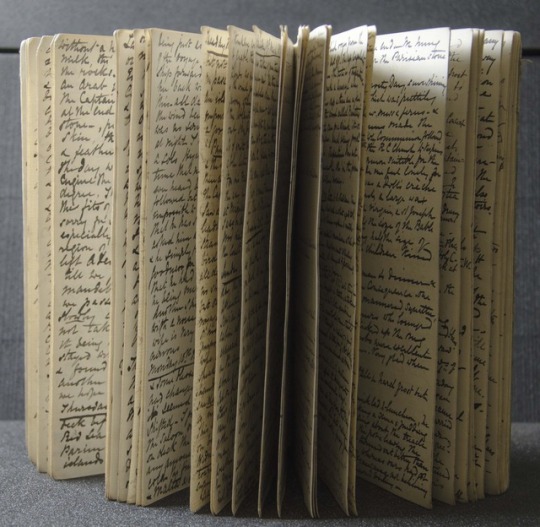
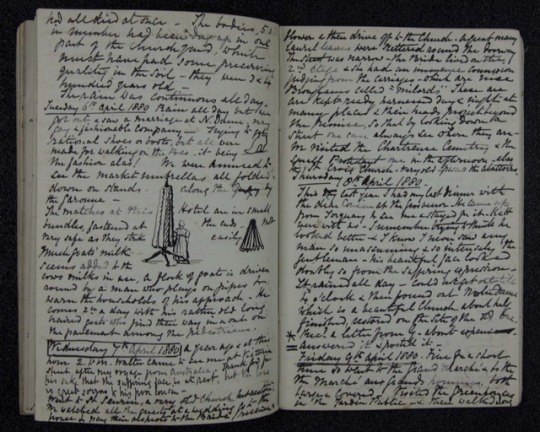
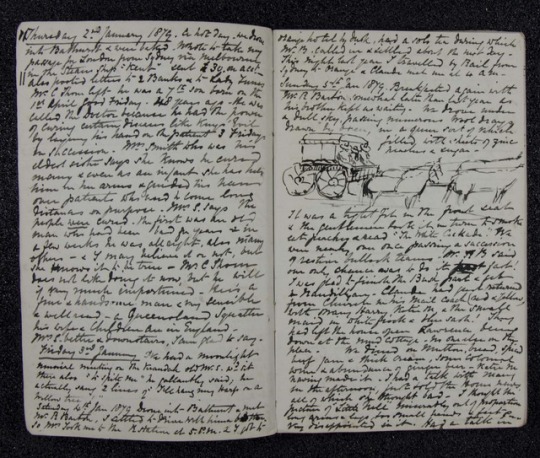



Illustrated manuscript journal of a voyage from Australia via the Middle East to Europe. 29 October 1878-27 November 1881.
This manuscript journal of an anonymous Englishwoman living in Australia describes her journey back to Europe via Yemen and Egypt. The journal starts on 29 October 1878 in Sydney, Rose Bay, and briefly describes some general events up to the author’s departure on 28th January 1879: “W’s birthday”, “Church in the afternoon”, “a hot day, we drove into Bathurst…”. On board of a steamship she first sails to Melbourne, and from there around Australia up north, in the direction of the Arabian Peninsula. Of particular interest are the detailed accounts of the Gulf of Aden, Port Said, El Qantara and the Suez Canal; she describes the area, some towns and villages, and the customs and appearance of the inhabitants she encounters along the way. Often times, the author makes use of drawings and illustrations to make her story more vivid.
Finally, she reaches England on 22 March 1879: “my first day at home”.
Posted by: Chhete Sherpa
NYU Abu Dhabi, Class of 2019
Student Library Assistant
1 note
·
View note
Photo

#stolen (at El Qantara, Shamal Sina', Egypt) https://www.instagram.com/p/B52AgxKH71sNmXxyXsm3ts1_Eg8bGYKvdxfiOU0/?igshid=16exlf7bmdom
1 note
·
View note
Video
youtube
[4K] Suez Canal Cruises from Port Said to El Qantara Bridge in Mediterra...
0 notes
Conversation
Coordinate Locations: Bridges, 1-61 (in order)
Bosphorus Bridge, Turkey
Castle Eaton Bridge, Wiltshire, England
Waterdale Bridge, Edmonton, Canada
Erskine Bridge, Erskine, Scotland
West Colorado Blv., Los Angeles, California
Abdoun Bridge, Amman, Jordan
Nanjing Yangtze River Bridge, Nanjing, China
Overtoun Bridge, Glasgow, England
Teatrainy Bridge, St. Petersburg, Russia
Forth Rail Bridge, Edinburgh, Scotland
Prince Edward Viaduct, Toronto, Canada
Stari Most, Mostar, Bosnia
Ouse Bridge, Goole, England
Jiu Bridge, Targu Jiu, Romania
Sarachane Bridge, Edirne, Turkey
Python Bridge, Amsteredam, Netherlands
Ponte Fabricio, Rome, Italy
El Camino Real, San Fransisco, California
Puente de Occidente, Antioquia, Colombia
Pont Gustave-Flaubert, Normany, France
Rotonda Los Fundadores, Evigado, Colombia
Gateshead Milennium Bridge, Gateshead, England
Swinford Toll Bridge, Oxforshire, England
Pont de Tancarville, Tancarville, France
Segovia Viaduct, Madrid, Spain
Victory Bridge, Jerevan, Armenia
Molja Bridge, Oulu, Finland
G5011 Wuhu-hefei Expressway, China
Frederick IX Bridge, Lolland/Falster, Denmark
Ponte Vecchio, Florence, Italy
Otley Bridge, West Yourshire, England
Erasumusbrug, Rotterdamn, Netherlands
Mahatma Gandhi Setu, Patna/Hajipur, India
Theodor Heuss Bridge, Wiesbaden/Hesse, Germany
Mubarak Peace Bridge, El-Qantara, Africa
Walterdale Bridge, Edmonton, Canada
Brooklyn Bridge, New York, New York
Bridge of Awe, Argyll, Scotland
Tsing Ma Bridge, Ma Way/Tsing Yi, China
Erneside Footbridge, Enniskillen, North Ireland
Humber Bridge, Kingston upon Hill, England
Ramstore Bridge, Astana, Kazachstan
Nuselsky Most, Prague, Czech Republic
Pont Neuf, Paris, France
Yokohama bay Bridge, Yokohama, Japan
Corinth Canal Footbridge, Peloponnese, Greece
Rue Des Abliaux, Tournai, Belgium
Cahill Expy/Sydney Harbour Bridge, Sydney, Australia
Tappan Zee Bridge, New York City, New York
Tower Bridge Road, London, England
Varney Bridge, Ennis, Montana
Foresthill Bridge, (Sierra Nevada foothills) California
Shakespeare Bridge, Los Angeles, California
Grand Duchess Carlotte Bridge, Luxembourg
West Gate Bridge, Melbourne Australia
Eiffel Bridge, Ungheni, Moldova/Romania
Aurora Bridge, Seattle, Washington
Tanners' Bridge, Tirana, Albania
New River Gorge Bridge, West Virginia, USA
Ashtarak Bridge, Aragatsotn, Armenia
Bridge of Sighs, Miraflores, Lima
13 notes
·
View notes
Quote
【9月12日 AFP】エジプトの北シナイ(North Sinai)県で11日、治安当局の車列が武装集団に襲撃され、18人が死亡した。治安筋や医療関係者らが明らかにした。同域では警察や軍が、攻撃を繰り返すイスラム過激派との戦いを続けている。
現場は同県ビルアルアベド(Bir al-Abed)付近。同国内務省は襲撃で死傷者が出たことは認めたが、その人数は明らかにしなかった。犠牲者の中に民間人が含まれているかどうかも不明。
事件は、港湾都市イスマイリア(Ismailiya)に近いカンタラ(Qantara)と、北シナイ県の県都アリーシュ(El-Arish)との間を通行していた治安当局の車列に、別の車1台が割り込もうとした際に発生した。
これについて、イスラム過激派組織「イスラム国(IS)」は傘下の通信社アマック(Amaq)を通じ、アリーシュ郊外での奇襲攻撃でエジプト軍兵士8人を殺害したと発表した。
エジプトでは2013年、軍がイスラム系のムハンマド・モルシ(Mohamed Morsi)元大統領を退陣に追い込んで以来、同県を拠点とするISの分派が攻撃を繰り返し、兵士や警察官数百人が犠牲になっている。(c)AFP
エジプトで治安当局の車列に襲撃、18人死亡 ISが犯行声明 写真1枚 国際ニュース:AFPBB News
0 notes
Text
El morisco Cide Hamete Bejarano, ¿autor del Quijote?
Dr Ismail El-Outmani
Université Mohamed V, Rabat, Maroc
« J’aime mieux… un grand nom qui paraît qu’un vieux nom qui s’éteint » (poeta anónimo)
Tratar de identificar a Cide Hamete Benengeli ha ocupado a más de un cervantista, pero la verdad es que hasta la fecha no se ha logrado una identificación definitiva del supuesto autor árabe del manuscrito (en árabe) de Don Quijote de La Mancha. Por consiguiente, no se ha explicado de manera convincente la opción de Cervantes por el elemento árabe para su novela y su autoría, sin olvidar los numerosos episodios "árabes" en el Quijote. Se han barajado varias hipótesis de trabajo examinando posibles fuentes del nombre del supuesto autor. Para algunos, Benengeli es "Benelayli", o "hijo del ciervo", contenido en el nombre "Cervantes". Para otros, significa "Aberenjenado", que procede de una deformación de "Berenjena", apodo corriente (?!) de los toledanos, según Sancho Panza ("he oído decir que los moros son amigos de berenjenas" P. II, Cap. 2). Otras lecturas han sugerido que significa o "hijo de la Biblia"), "hijo del ángel" o "hijo del valioso". Sin embargo, no cabe duda de que la duda permanece, a pesar del tiempo transcurrido y de los esfuerzos dedicados al tema.
Nuestra intención aquí es participar en esa labor de identificación de Benengeli, tomando en consideración no sólo el nombre en sí, sino el contexto histórico que vio aparecer el Quijote. Empezaremos nuestra andanza con un nombre: Ahmad ben Qásim Al-Hayari al-Andalusi, más conocido entre los estudiosos del tema morisco como Afuqqay al-Hayari. Nacido en tierras de Granada, huyó de España a Marruecos (o Berbería) buscando libertad, poniéndose al servicio del Sultán, que le nombró traductor oficial, y luego embajador ambulante. Fue asimismo protector de numerosos andalusíes huidos al Norte de África y defensor de otros huidos a Turquía. Mantuvo vivas polémicas teológicas con exponentes de la cristiandad y el judaísmo, y, además de redactar sus propias memorias, llego a escribir/ traducir alguna(s) obra(s) de ingeniería militar.
Al parecer, Afuqqay Al-Hayari era conocido en su época granadina con el apodo cristiano de Bejarano. Retengamos el apodo Bejarano, teniendo presente, uno, que desconocemos el porqué le fue puesto, y, dos, que la Primera parte del Quijote fue dedicada al Duque de Béjar, a pesar de ser éste hombre poco letrado y nada interesado en Cervantes y lo suyo. ¿No era tal vez para evocar a Bejarano? De todos modos, para tener a nuestro personaje lo más cerca posible, tanto de nosotros como de su ambiente granadino, vamos a llamarle por su nombre de pila, Hamete, anteponiéndole, eso sí, el apelativo Cide, que indica cortesía, o formalidad. Cide Hamete Bejarano es pues su nombre completo. Cide Hamete tenía una instrucción en el Islam que le permitía recitar el Corán y manejar libros en árabe. Naturalmente, tenía que hacerlo en secreto, aplicando, como muchos otros moriscos, la licencia islámica de Taqiyya, para no tener problemas con la Inquisición. No obstante, Cide Hamete seria llamado a participar en la traducción de los enigmáticos Libros Plúmbeos, porque aparentemente tenía, además de una educación, una conducta cristiana suficiente como para ganarse la confianza del arzobispo de Granada Pedro de Vaca Castro.
Los datos más antiguos disponibles sobre nuestro personaje datan de 1590, año en que le encontramos en Granada. En este episodio biográfico, Cide Hamete Bejarano es llamado por el arzobispo de Granada para hacer la versión árabe de un pergamino descubierto en la Torre Turpiana en 1588. Los datos esenciales a retener: nuestro Ahmad, Hamete para los hispanohablantes, era morisco, granadino y traductor; mientras que el pergamino era un documento apócrifo que precedería una serie de documentos conocida con el nombre de Libros Plúmbeos.
Sumariamente, diremos que en 1588, "aparecieron" entre los escombros del antiguo minarete de la mezquita mayor nazarí, conocido también como Torre Vieja o Turpiana y ubicado a poca distancia de las tumbas de los Reyes Católicos, que unos obreros moriscos estaban derrumbando, una caja de plomo con varios objetos y un pergamino escrito en árabe, castellano y latín que daba las primeras noticias concretas acerca de San Cecilio, patrono de la ciudad. El evento causa verdadera conmoción religiosa en Granada, y su repercusión se extendió a toda España, y el Rey lo recibe como mensaje divino. Tras este ensayo general, y el éxito obtenido, « aparecieron » entre 1595 y 1598 veintidós libros plúmbeos.
Tras los "hallazgos", había que traducir al castellano los textos en árabe, y comprobar su originalidad para certificar la veracidad de su historia, o su falsedad. Los traductores de los Libros Plúmbeos que se citan normalmente son Alonso del Castillo (médico morisco e intérprete de Felipe II), Miguel de Luna (médico morisco y traductor de árabe para Felipe II, y autor de La verdadera historia del rey Rodrigo…), el licenciado Luis Fajardo (catedrático de árabe en la Universidad de Salamanca), y Francisco López Tamarid (racionero mayor de la Catedral). Pero hay un quinto traductor que no mencionan las fuentes españolas; personaje curiosísimo que guarda, a nuestro modo de ver, muchos secretos sobre la concepción del Quijote. Se trata nada más y nada menos que de Cide Hamete Bejarano, el cual afirma en sus Memorias (Nássir al-Din…) que adquirió un cierto renombre entre los granadinos, porque había sabido interpretar los pergaminos mejor que los demás traductores.
Leyendo el contexto histórico de los Libros Plúmbeos, descodificando los elementos relativos a su "aparición" y "apariencia", podemos concluir que se trataba esencialmente de una obra, pseudo-anónima, escrita principalmente en lengua árabe que pretende narrar una historia verdadera. Hoy sabemos, como señala M. García-Arenal, que los Libros Plúmbeos "presentan una clara intención de apoderarse de la historia para influenciar la opinión pública española en general y la monarquía en particular, en favor de la comunidad morisca dotándola de un origen antiguo, cristiano, sagrado y al tiempo defendiendo su principal seña de identidad, la lengua ]árabe, lengua del Corán" (AL-QANTARA, p. 323). En otras palabras, hasta en el caso de deber extirpar el Islam, el árabe debía ser considerado una lengua que podía convivir armoniosamente con la fe cristiana (Van Koningsveld & Wiegers, AL-QANTARA, p. 350).
Los autores de los Libros Plúmbeos pretendían pues contar una historia verdadera en lengua árabe. El Quijote a su vez es presentado como una obra escrita originalmente en lengua árabe por un autor árabe llamado Cide Hamete Benengeli para narrar la verdadera historia de un caballero andante llamado Don Quijote de La Mancha. Lo que hace Cervantes, obsesionado por su preocupación con el linaje, es denunciar, parodiar y subvertir (en el sentido bajtiniano), empezando por la forma del discurso, la estrategia morisca, burlándose de sus mentirosos autores (moriscos), de la falsedad (en vez de veracidad) de su historia. Entendemos que ésta debió ser percibida por los responsables religiosos y los intelectuales de la época como una "historia" peligrosa, porque de ser verdadera echaba por tierra tantas doctrinas de conquistas cristianas y expulsiones de "moros" / moriscos, al considerar la lengua árabe y sus hablantes, los moriscos o "cristianos nuevos", tan "viejos" como los "cristianos viejos".
No pretendemos ser los primeros en señalar la conexión parodística entre el Quijote y (el caso de) los Libros Plúmbeos (Lathrop, Case, etc), pero sí examinar elementos nuevos que sugieren o confirman la hipótesis de una reacción antimorisca por parte de Cervantes, además de identificar a Cide Hamete Benengeli. La idea capital es que Cervantes, que seguía de cerca el asunto de los Libros Plúmbeos y sus repercusiones, tal vez se haya dejado "inspirar" por Cide Hamete Bejarano, personaje morisco, traductor, involucrado directamente en la "historia" de los Libros Plúmbeos y su traducción, además de ser concernido (en cuanto morisco) por su contenido. Estos indicios contextuales son reforzados por la semejanza fonética entre Cide Hamete Berenjena y Cide Hamete Bejarano. Al decir Berenjena por Benengeli, lo que hace Sancho es reproducir el sonido. Recordemos a este punto la regla fonética de la que se sirve Cervantes en la invención de nombres. De hecho, Bejarano no dista nada de Berenjena. Sin embargo, ello no resuelve por completo el enigma de “Benengeli”.
En realidad, una vez establecida la mencionada conexión (bejarana ?!) entre Don Quijote y la cuestión morisca a través de los Libros Plúmbeos y el quinto traductor, no ha sido muy difícil dar con el significado de "Benengeli". “Benengeli”, o “Ben-enegeli” quiere decir en árabe “hijo de bastardo”, o “hijo de sangre no limpia”. Cide Hamete Bejarano era morisco, por lo tanto “hijo de bastardo” ; lo que equivale a decir, desde la óptica de Cervantes y de su época, un “cristiano nuevo”. Hay que señalar en este contexto que dentro del antagonismo entre cristianos viejos y cristianos nuevos existía la creencia de aquellos que estos pertenecían a una "raza bastarda" que descendía de Ismael, mientras los cristianos descienden directamente de Isaac.
Esto es un avance de un trabajo mayor, en preparación, donde materias aquí apenas insinuadas tendrán un desarrollo más extenso. Se trata sintéticamente de proponer una lectura del contexto, o de la "fantasía morisca" que caracteriza la concepción del Quijote y la incertidumbre autoral del mismo. Sin embargo, ya se puede percibir, a la luz de lo expuesto más arriba, que la lectura que proponemos del nombre Cide Hamete Benengeli y de lo morisco en el Quijote puede ser más plausible, o, al menos, menos implausible que las entretenidas hasta la fecha.
Referencias Bibliográficas:- Al-Hayari, Ahmad Benqasem, Nássir al-din alá al-qawm al-káfirin (texto bilingüe, árabe-inglés), traducción & edición crítica de P.S. Van Koningsveld, Q. Al-Samarrai y G. Wiegers, Madrid: CSIC y AECI, 1997.- Case, Thomas E., “Cide Hamete Benengeli y los Libros plúmbeos del Sacromonte”, artículo proveniente de http://www.alyamiyah.com/cema- Castro, A., Hacia Cervantes, Madrid: Taurus, 1957.- Cervantes, Miguel de, Don Quijote de La Mancha (2 tomos), ed., introd. y notas de M. De Riquer, Barcelona : RBA, 1994- Fuentes Fernández, Francisco Javier, "Interpretación de algunos pasajes del Quijote", artículo proveniente de http://www.alyamiyah.com/- Lathrop, Thomas, A., “Cide Hamete Benengeli y su manuscrito”, en Cervantes: su obra y su mundo (Actas I Congreso sobre Cervantes), Dir. M.C. de Val, Madrid: EDI-6, 1981, pp. 693-7.- Oliver Asin, J., Conferencias y apuntes inéditos, ed. D. Oliver, Madrid: AECI, 1996.- VV.AA.: AL-QANTARA, (con sección monográfica II en torno a los Plomos del Sacromonte), Madrid : CSIC, Vol. XXIV, Fasc.2, 2003.- VV.AA., Insula, 538 (número monográfico extraordinario sobre el Quijote), Octubre 1991.
© Ismail El-Outmani 2005
Espéculo. Revista de estudios literarios. Universidad Complutense de Madridhttp://www.ucm.es/info/especulo/numero30/cidiham.html
0 notes
Link
#SabunPackingMachine
Hexa Meccanica is manufacturer Bath Soap Wrapping Machine In El Qantara Egypt
https://api.whatsapp.com/send?phone=+919408841211
#SabunPackingMachine #El Qantara #Egypt
0 notes
